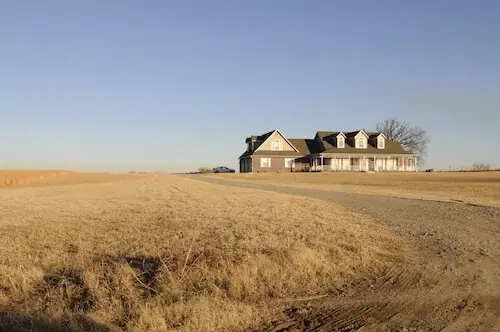
Overview of Oklahoma Taxes
Property taxes in Oklahoma are among the lowest in the region and the U.S. The median annual property tax paid by homeowners in Oklahoma is just $1,076, the seventh lowest amount of any U.S. state.
| Enter Your Location Dismiss | Assessed Home Value Dismiss |
| Average County Tax Rate 0.0% | Property Taxes $0 (Annual) |
| of Assessed Home Value | |
| of Assessed Home Value | |
| National | of Assessed Home Value |
- About This Answer
To calculate the exact amount of property tax you will owe requires your property's assessed value and the property tax rates based on your property's address. Please note that we can only estimate your property tax based on median property taxes in your area. There are typically multiple rates in a given area, because your state, county, local schools and emergency responders each receive funding partly through these taxes. In our calculator, we take your home value and multiply that by your county's effective property tax rate. This is equal to the median property tax paid as a percentage of the median home value in your county.
Oklahoma Property Taxes

Property taxes in the Sooner State are among the lowest in the region and the U.S. The median annual property tax paid by homeowners in Oklahoma is just $1,076, the seventh lowest amount of any U.S. state, and less than half the national median. One reason for these low taxes is that state laws does not allow assessed home values to increase more than 3% from the previous year’s value. Below, we will review that and other key property tax rules in Oklahoma.
Looking to calculate your potential monthly mortgage payment? Check out our monthly mortgage payment calculator.
How the Oklahoma Property Tax Works
The amount of property taxes homeowners in Oklahoma pay depends on the taxable value of their property and their total tax rate. Taxable value is based on, but not necessarily equal to, market value.
County assessors determine the market value of property in their jurisdictions through an annual assessment. Most assessments are not done in person but are based on recent sales of comparable properties. Assessors are only required to visit each property physically once every four years. Annual increases in a property’s assessed value are capped at 3% for residential homestead and agricultural property. All other property has a cap of 5%. Senior homeowners may also qualify for the senior valuation freeze, which prevents home values from increasing.
The taxable value of a property is equal to the assessed value times the local assessment ratio (between 10% and 15%, depending on county), minus any exemptions. The most common exemption is the homestead exemption, which lowers taxable value by $1,000 on owner-occupied, primary residences. Other exemptions are available to veterans, seniors and disable persons.
So, for example, let’s say your assessed value is $100,000 and you live in a homestead residence in Tulsa County, where the assessment ratio is 11%. Your taxable value would be $11,000 minus $1,000 for the homestead exemption: $10,000 total. Your tax rate would apply to that amount.
Before officially becoming an Oklahoman, or if you’re already a resident and are looking to refinance, take a look at our Oklahoma mortgage guide to better understand mortgages in the Sooner State.
Oklahoma Tax Rates
Tax rates in Oklahoma are set by multiple tax authorities in every county and city, and then totaled for each district. Rates depend on budgetary needs, but increases are usually subject to voter approval. Rates are set as mills, with one mill equaling $1 in taxes per $1,000 in taxable value. For a home with a taxable value of $10,000, a mill rate of 90 mills would mean taxes of $900.
Mill rates vary by locality, so it’s useful to compare property taxes by looking at a home’s effective tax rate. An effective property tax rate is the amount of property taxes paid annually as a percentage of home value. The below shows median home value, tax payment and average effective tax rates for every county in Oklahoma.
Oklahoma County
Oklahoma County is the most populous county in the state, and it contains the state capital, Oklahoma City. It has the second highest average tax rate of Oklahoma’s 77 counties. The average effective property tax rate in Oklahoma County is 1.05%.
In the parts of Oklahoma City that are included in the Oklahoma City School District, the total mill rate for 2017 was 113.44 mills. More than half of that is levied by the school district, which has a rate of 59.36 mills. Metro Technology Centers, the city’s public technical school, levies a tax of 15.45 mills.
Tulsa County
Situated along the Arkansas River in northeast Oklahoma, Tulsa County has the second highest property tax rates in the state. The county’s average effective property tax rate of 1.10% is well above the state average (but still lower than the national average).
Total 2017 mill rates in Tulsa County ranged from a low of about 90 mills (in parts of the Keystone School District) to a high of almost 140 (in multiple school districts within the city of Tulsa). The total rate in the Tulsa School District was 137.08 mills. That means homeowners within the Tulsa School District pay $137.08 in tax for every $1,000 in taxable value. Taxable value is equal to 11% of assessed value in Tulsa County.
Cleveland County
Cleveland County is a largely suburban and rural county located south of Oklahoma City. It contains the city of Norman and the main campus of the University of Oklahoma. It also has some of the highest property taxes in the state.
The median annual property tax paid by homeowners in Cleveland County is $1,689, which ranks first in Oklahoma. However, home values in Cleveland County are also among the highest in the state. According to the U.S. Census Bureau, the median home value in Cleveland County is $150,400.
Comanche County
Comanche County, in southern Oklahoma, has the fifth highest effective property tax rate in the state. The average rate in Comanche County is 0.97%, compared to a state average of 0.89%. Total mill rates in the county range from about 73 mills to 110 mills among the county’s 37 different districts.

Canadian County
The average effective property tax rate in Canadian County is 1.03%, fourth highest in the state. It also has the fourth highest median home value in the state. A home with a value of $150,000 (close to the county median) would pay taxes of $1,545 annually based on the average effective property tax rate.
Rogers County
Rogers County sits northeast of Tulsa and has a population of about 90,000. It is part of the Tulsa Metropolitan region, but tax rates in Rogers County are significantly lower than those in Tulsa. For example, in the county seat of Claremore, the total 2017 mill rate was about 104 mills. The mill rate in Tulsa was about 137 mills. (Both counties have an assessment ratio of 11%.)
Payne County
Located about 60 miles from both Tulsa and Oklahoma City, Payne County has property tax rates near the state average. The median property tax for homeowners in Payne County is $1,302 annually. That is the sixth highest amount in the state, but is about 40% less than the national median.
Wagoner County
Wagoner County stretches from Fort Gibson Lake west to Tulsa County. It is the eighth largest Oklahoma County, with a population of about 76,000. Its average effective property tax rate is 0.87%, slightly less than the state average.
Muskogee County
The median home value in Muskogee County is $94,800 according to the U.S. Census Bureau. That is significantly lower than the rest of Oklahoma’s most populous counties, as are the annual property taxes paid by Muskogee County homeowners. The median annual property tax in Muskogee County is just $686.
Creek County
Creek County was established in 1907, at the same time Oklahoma gained statehood. It is located southwest of Tulsa, between Tulsa and Oklahoma City. The average effective property tax rate in Creek County is 0.78%. At that rate, the annual taxes on a home worth $100,000 would be $780.
Places Receiving the Most Value for Their Property Taxes
SmartAsset’s interactive map highlights the places across the country where property tax dollars are being spent most effectively. Zoom between states and the national map to see the counties getting the biggest bang for their property tax buck.
Methodology
Our study aims to find the places in the United States where people are getting the most value for their property tax dollars. To do this, we looked at property taxes paid, school rankings and the change in property values over a five-year period.
First, we used the number of households, median home value and average property tax rate to calculate a per capita property tax collected for each county.
As a way to measure the quality of schools, we analyzed the math and reading/language arts proficiencies for every school district in the country. We created an average score for each district by looking at the scores for every school in that district, weighting it to account for the number of students in each school. Within each state, we assigned every county a score between 1 and 10 (with 10 being the best) based on the average scores of the districts in each county.
Then, we calculated the change in property tax value in each county over a five-year period. Places where property values rose by the greatest amount indicated where consumers were motivated to buy homes, and a positive return on investment for homeowners in the community.
Finally, we calculated a property tax index, based on the criteria above. Counties with the highest scores were those where property tax dollars are going the furthest.
Sources: US Census Bureau 2018 American Community Survey, Department of Education
